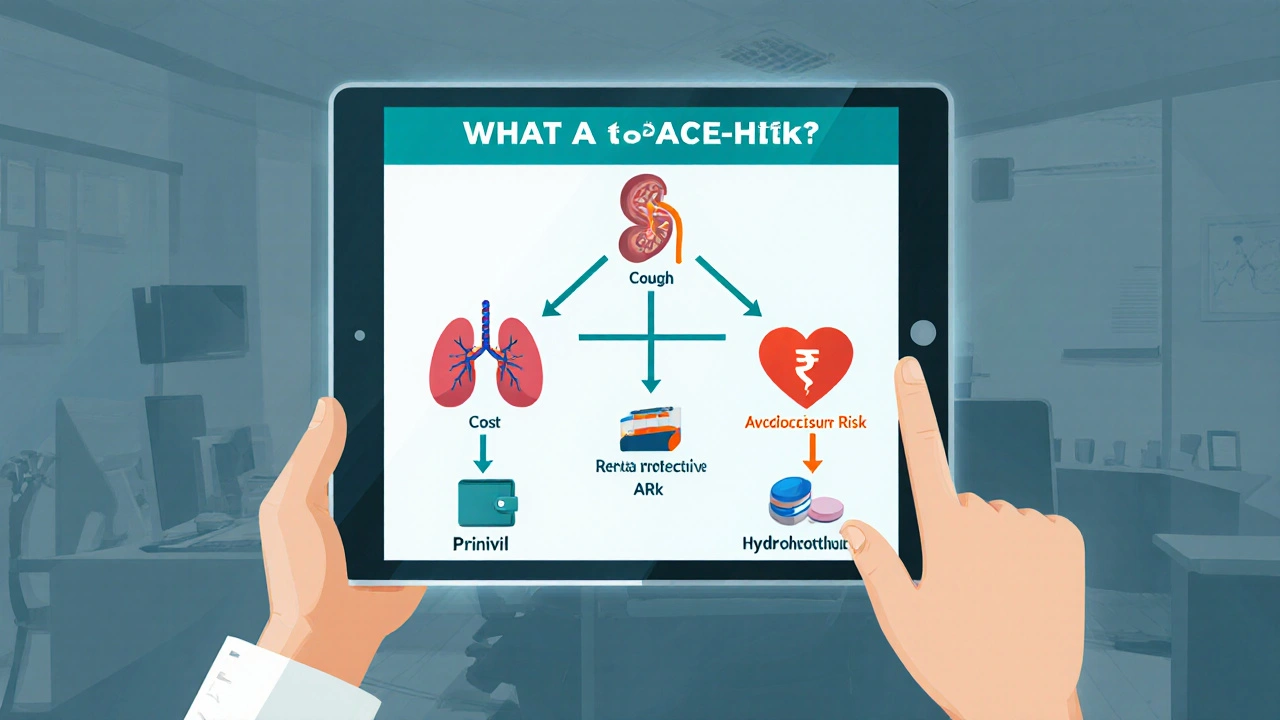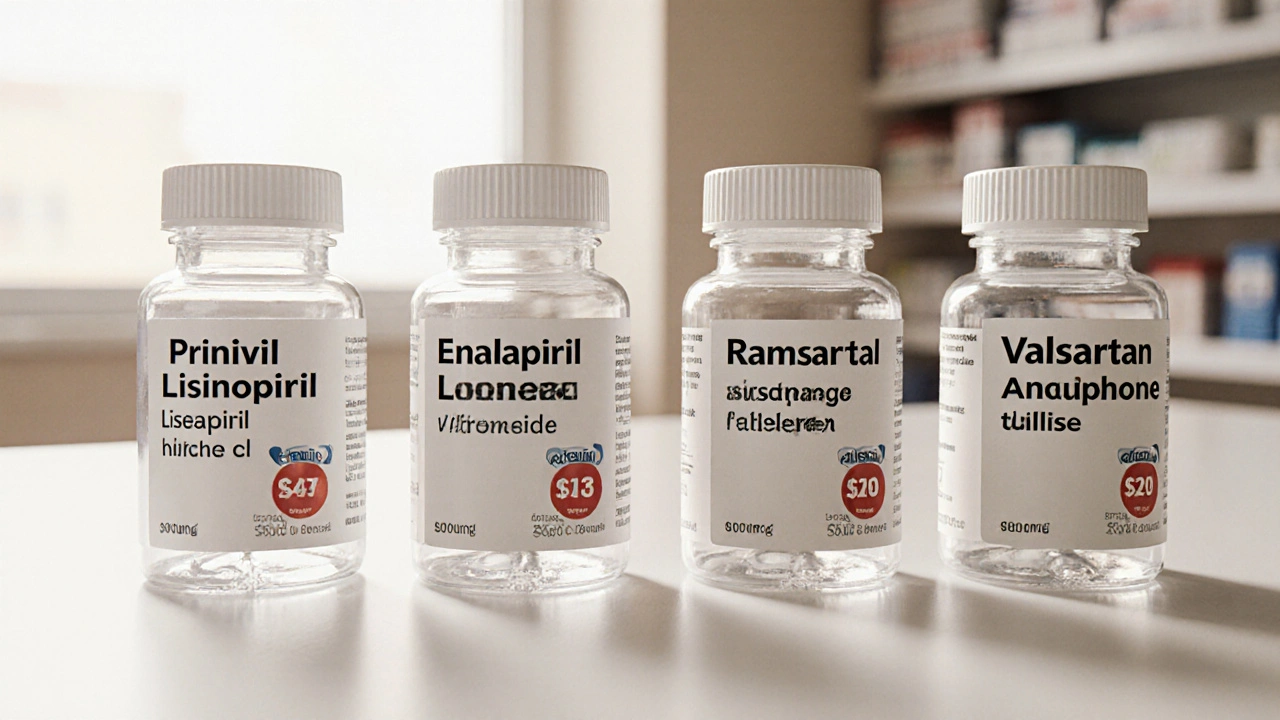14 Oct 2025
- 16 Comments
Blood Pressure Medication Selector
Find Your Best Blood Pressure Medication
Answer a few simple questions about your health situation to identify the blood pressure medication that may work best for you.
Answer the questions above to see your recommendation
When it comes to managing high blood pressure, Prinivil (Lisinopril) is one of the most prescribed ACE inhibitors. But you’re not limited to that single pill - dozens of drugs can achieve the same goal, each with its own pros and cons. This guide breaks down how Prinivil stacks up against the most common alternatives, helping you decide which option aligns with your health, budget, and lifestyle.
Key Takeaways
- Prinivil offers proven blood‑pressure reduction at a low cost, but cough is a frequent side effect.
- Other ACE inhibitors (Enalapril, Ramipril) share the same mechanism; they differ mainly in dosage flexibility and price.
- ARBs such as Losartan and Valsartan avoid cough but tend to be pricier.
- Calcium‑channel blockers (Amlodipine) and thiazide diuretics (Hydrochlorothiazide) work through different pathways and are useful when ACE inhibitors aren’t tolerated.
- Choosing the right pill hinges on your kidney function, electrolyte balance, and any existing heart conditions.
Understanding the Players
Before diving into the comparison, let’s set the stage with brief definitions of each drug class.
Enalapril is an ACE inhibitor that works by blocking the conversion of angiotensin I to angiotensin II, relaxing blood vessels.
Ramipril shares the same ACE‑inhibiting action but is often prescribed for patients at higher risk of heart failure.
Losartan belongs to the ARB (angiotensin‑II receptor blocker) class, preventing angiotensin II from binding to its receptors.
Valsartan is another ARB that’s widely used when ACE inhibitors cause a persistent cough.
Amlodipine is a calcium‑channel blocker that dilates arteries by inhibiting calcium influx into smooth‑muscle cells.
Hydrochlorothiazide is a thiazide diuretic that reduces blood volume by increasing urine output.
Hypertension is the chronic condition of elevated arterial pressure, typically defined as >130/80mmHg in recent guidelines.
Side‑Effect Landscape
Side effects often dictate whether a patient sticks with a medication. Here’s a quick snapshot:
- Prinivil (Lisinopril): dry cough (10‑15% of users), elevated potassium, rare angio‑edema.
- Enalapril: similar cough rate, slightly higher incidence of dizziness.
- Ramipril: lower cough incidence (≈8%) but more reports of fatigue.
- Losartan & Valsartan: minimal cough, occasional dizziness, higher cost.
- Amlodipine: peripheral edema, flushing, very low cough risk.
- Hydrochlorothiazide: increased urination, low potassium, modest gout risk.

Cost Comparison (Average Australian Prices)
| Drug | Typical Dose | Common Uses | Avg. Cost | Notable Side Effects |
|---|---|---|---|---|
| Prinivil (Lisinopril) | 10‑40mg daily | Hypertension, post‑MI, heart failure | $12 | Cough, hyperkalaemia |
| Enalapril | 5‑20mg daily | Hypertension, diabetic nephropathy | $15 | Cough, dizziness |
| Ramipril | 2.5‑10mg daily | Hypertension, heart failure prevention | $18 | Fatigue, cough |
| Losartan | 25‑100mg daily | Hypertension, diabetic nephropathy | $30 | Low cough risk, dizziness |
| Valsartan | 80‑320mg daily | Hypertension, heart failure | $32 | Headache, rare angio‑edema |
| Amlodipine | 2.5‑10mg daily | Hypertension, angina | $22 | Peripheral edema, flushing |
| Hydrochlorothiazide | 12.5‑50mg daily | Hypertension, edema | $10 | Low potassium, increased urination |
When to Prefer Prinivil (Lisinopril)
If you need a well‑studied, inexpensive ACE inhibitor and you don’t have a history of cough or high potassium, Prinivil is a solid first‑line choice. It also has strong evidence for post‑myocardial‑infarction protection.
Patients with chronic kidney disease (CKD) often benefit from the renal‑protective effects of ACE inhibitors, but you’ll need regular blood‑work to monitor creatinine and potassium.
When Alternatives Shine
Persistent cough? Switch to an ARB like Losartan or Valsartan; they block the same pathway downstream without triggering the cough reflex.
If you have “ACE‑inhibitor‑induced angio‑edema,” an ARB is generally safer.
When you need additional blood‑pressure lowering beyond what a single ACE inhibitor can provide, combining an ACE inhibitor with a thiazide diuretic (e.g., Hydrochlorothiazide) is common practice.
For patients with peripheral vascular disease or who experience edema on ACE inhibitors, a calcium‑channel blocker such as Amlodipine can be added or used alone.

Practical Decision Tree
- Do you have a history of ACE‑inhibitor cough or angio‑edema?
If yes → consider an ARB (Losartan/Valsartan). - Is cost a primary concern?
If yes → stick with Prinivil or Hydrochlorothiazide (cheapest). - Do you need extra renal protection (e.g., diabetic nephropathy)?
If yes → ACE inhibitor or ARB, monitor labs closely. - Do you have peripheral edema or need a vasodilator that avoids cough?
If yes → Amlodipine or combination therapy.
Monitoring & Follow‑Up
Regardless of the pill you pick, schedule follow‑up labs within 2‑4 weeks of starting therapy. Track:
- Blood pressure (target <130/80mmHg for most adults).
- Serum creatinine and potassium (especially with ACE inhibitors/ARBs).
- Any new symptoms: cough, swelling, dizziness.
Bottom Line
Prinivil remains a go‑to drug for many Australians because of its affordability and proven track record. However, the modern formulary offers several viable alternatives that can sidestep its most common side effect-cough-while still delivering strong blood‑pressure control. Talk with your GP or pharmacist, weigh cost against tolerability, and you’ll land on the medication that fits your life best.
Frequently Asked Questions
Can I switch from Prinivil to an ARB without a washout period?
Yes. Most clinicians advise a 24‑hour gap between stopping an ACE inhibitor and starting an ARB to reduce the rare risk of overlapping angio‑edema. Check with your doctor for exact timing.
Is Prinivil safe during pregnancy?
No. ACE inhibitors, including Prinvil, are classified as Category D in pregnancy because they can harm the developing fetus. Pregnant patients should switch to a medication like labetalol.
How does a thiazide diuretic compare to Prinvil for first‑line therapy?
Guidelines often recommend an ACE inhibitor or ARB as first‑line for most adults, but a thiazide (e.g., Hydrochlorothiazide) can be equally effective, especially in older patients. Thiazides are cheaper but may cause low potassium and increased urination.
What should I do if I develop a dry cough on Prinvil?
Report the symptom to your GP. They may try a lower dose, switch to an ARB, or add a cough‑suppressing measure. Most people who switch to an ARB see the cough disappear within weeks.
Are there any food or supplement interactions with Prinvil?
Avoid high‑potassium foods (e.g., bananas, avocados) if you’re on any ACE inhibitor, as they can raise serum potassium. Also, limit NSAIDs (ibuprofen, naproxen) as they may blunt the blood‑pressure‑lowering effect.


Julia Odom
October 14, 2025When evaluating antihypertensive therapy, it's crucial to balance efficacy, cost, and tolerability. Prinivil offers a proven track record at a modest price point, yet its cough incidence can be a deterrent for some patients. Alternatives such as ARBs provide comparable blood pressure control without the cough, though they often carry a higher price tag. For patients with chronic kidney disease, the renal‑protective effects of ACE inhibitors remain valuable. Ultimately, shared decision‑making should guide the final choice.
Danielle Knox
October 18, 2025Oh sure, because we all have endless budgets for overpriced ARBs. The cheap ACE inhibitors work just fine until they give you a cough that rivals a wet weekend. And of course, everyone loves paying extra for the same blood pressure drop.
Mark Evans
October 22, 2025I see where you're coming from, but don't discount the renal‑protective benefits of ACE inhibitors, especially for diabetic patients. Those drugs may cause a cough, but the trade‑off can be worth it when you need to preserve kidney function. If you monitor potassium and creatinine closely, the risk is manageable. Pairing a low‑dose ACE inhibitor with a thiazide can also improve control without escalating costs dramatically.
Greg McKinney
October 26, 2025Meh, the chart looks fine. Nothing groundbreaking here.
George Gritzalas
October 30, 2025Honestly, the author missed several commas in the side‑effects table, which makes the whole thing look amateurish.
Alyssa Matarum
November 3, 2025This guide nails the basics.
Mary Akerstrom
November 8, 2025Great job on the layout it really helps people compare meds quickly thanks
Delilah Allen
November 12, 2025Considering the biochemical cascade, one must ask: does the cost truly outweigh the physiological harmony achieved?;
Nancy Lee Bush
November 16, 2025I love the decision tree format-so intuitive! :)
Dan Worona
November 20, 2025Did you know the pharma lobby influences these price comparisons? Look at the hidden fees.
Chuck Bradshaw
November 24, 2025Everyone forgets that the half‑life of lisinopril makes adherence easier-obviously missed by newbies.
Howard Mcintosh
November 28, 2025Yo the low cost on lisinopril is lit fr, but watch out for that cough.
Jeremy Laporte
December 2, 2025Thanks for breaking down the side effects, super helpful for folks like me who are new to BP meds.
Joshua Ardoin
December 6, 2025Amlodipine for edema? 💊👍
Meigan Chiu
December 10, 2025While the table lists Hydrochlorothiazide as cheapest, the real‑world cost plus lab monitoring can make it less appealing for some patients.
Patricia Hicks
December 15, 2025Reading through this comparison really made me appreciate how nuanced hypertension management can be.
First, the cost factor is undeniably important for many patients, especially those without insurance coverage.
Second, the cough associated with ACE inhibitors like Prinivil can seriously affect quality of life, leading some to abandon therapy prematurely.
Third, ARBs such as Losartan and Valsartan sidestep that issue, but the price jump isn’t trivial.
Fourth, calcium‑channel blockers provide a solid alternative when peripheral edema is a concern, though they bring their own side‑effects like flushing.
Fifth, thiazide diuretics remain the most affordable option, but electrolyte disturbances require careful monitoring.
Sixth, renal protection is a key benefit of ACE inhibitors and ARBs for patients with diabetic nephropathy, making them a first‑line consideration despite the cough risk.
Seventh, combination therapy-pairing a low‑dose ACE inhibitor with a thiazide-can achieve synergistic blood pressure reduction while mitigating individual drug side‑effects.
Eighth, patient adherence improves when dosing is simple; once‑daily regimens like Prinvil’s 10‑40 mg are convenient.
Ninth, clinicians should always individualize therapy based on comorbidities, lifestyle, and patient preferences.
Tenth, shared decision‑making, as highlighted in the interactive tool, empowers patients to choose a regimen they can stick with.
Eleventh, regular follow‑up labs within the first month are essential to catch hyperkalaemia or rising creatinine.
Twelfth, education about potential cough and when to report it can prevent unnecessary discontinuation.
Thirteenth, for those who experience chronic cough, switching to an ARB can be a seamless transition.
Fourteenth, insurance formulary restrictions often dictate the final choice, so checking coverage early saves headaches.
Fifteenth, overall, the best blood pressure pill is the one the patient can afford, tolerate, and take consistently.
Sixteenth, keep this guide handy when discussing options with your doctor-it’s a solid reference point.